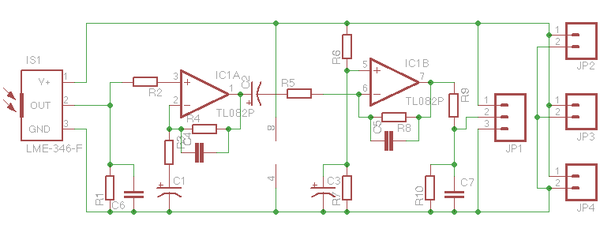ublo
bogdan's (micro)blog
bogdan » cheap low power PIR sensor
09:12 pm on Sep 23, 2012 | read the article | tags: hobby
recently i had a problem. i needed to build a wireless PIR sensor that could be powered by a LiPo 1400mAh battery. seems like a lot of juice, but thinking that the wixel draws usually almost 30mA and a mangled PIR sensor 8mA, the sensor would have to be recharged every 1.5 days. not a practical approach. through some neat hack i managed to send the wixel in sleep mode, making it draw less than 100uA, but still had the power hungry PIR sensor.
today i managed to solve this problem also. using a cheap (~$15) PIR sensor with a nice housing and a few components i managed to bring the PIR sensor as low as 1.6mA (measured), making the battery last for 34 days. here’s how:
first remove the PIR element. it’s quite big component, encased in metal and with a window for sensing IR radiation. be careful when removing it as it is quite a sensitive component! then gather the components and build this schematic:

components list:
IS1 is the PIR element. this component was on my Eagle library and matched the dimensions of the one i recovered.
R1, R3 = 47K
R2 = 18K
R4, R8 = 1M
R5 = 1K
R6, R7, R9 = 100K
R10 = 330K
C1, C7 = 10uF (there is no mistake! C7 is 10uF but can be polarized. i used tantalum capacitors)
C2, C3 = 4.7uF
C4, C5, C6 = 10nF
IC1A, IC1B = TL082
JP1 = a 3 pin connector in which 1 = +3V3, 2 = signal (connect to wixel P1_0), 3 = GND
JP2, JP3, JP4 = 2 pin connectors as there’s always a good idea to serve power to other devices
notes:
the R9, R10, C7 group sets the sensitivity of the PIR sensor. this setup worked for what i wanted but trust me, it took about 3 hours of testing to get to those values and configuration. the interrupt on P1_0 of the wixel should be configured for raising edge, not falling. R10 is needed to lower the IC1B output potential below the interrupt threshold. an IR event sends the IC1B output close to 3.3V followed by a drop to almost 0V then back to almost 1.65V (this is the value you should have when idle). with R9/R10 the idle voltage is close to 1.26V making the interrupts stable. setting R10 higher, moves this point close to 1.65V when the interrupts are unstable. making it lower decreases the sensitivity. i don’t recommend getting under 56K (standard value) as the interrupts cannot be triggered anymore.
bibliography:
i drew inspiration from Micropik’s D203B PIR element datasheet.
find me:
in my mind:
- #artist 2
- #arts 4
- #away 3
- #bucharest 1
- #buggy 4
- #business 1
- #clothes 1
- #comics 1
- #contest 3
- #dragosvoicu 1
- #education 1
- #food 2
- #free-ideas 1
- #friends 14
- #hobby 22
- #howto 9
- #ideas 30
- #life lessons 4
- #me 59
- #mobile fun 4
- #music 51
- #muvis 17
- #muviz 13
- #myth buxter 1
- #nice2know 15
- #night out 1
- #openmind 2
- #outside 3
- #poems 4
- #quotes 1
- #raspberry 4
- #remote 56
- #replied 51
- #sci-tech 7
- #sciencenews 1
- #sexaid 7
- #subway 39
- #th!nk 5
- #theater 1
- #zen! 4